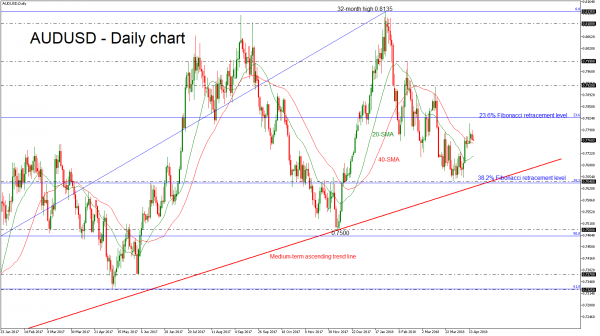Australia’s employment report for March is likely to attract attention and is scheduled for release on Thursday at 0130 GMT. The unemployment rate is forecasted to tick lower to 5.5% for the month of March versus 5.6% the preceding month, while the employment change is expected to show that the economy added 3,500 jobs, much more from the previous month. Meanwhile, the participation rate is predicted to remain unchanged at 65.7%. Could a stronger than expected employment data affect the local currency?
The employment report overnight could drive aussie/dollar higher if the releases beat expectations. It is worth mentioning that Australian employment increased by 17,500 in February compared with 12,500 the prior month, while in the month of March it is forecasted to grow by 21,000 jobs. However, weaker releases could push the RBA to be neutral for a longer period.
Turning to monetary policy, during Tuesday’s Asian session, the Reserve Bank of Australia (RBA) released its latest meeting minutes and showed its Board to agree the next move in rates was more likely to be up than down, assuming the economy gathered momentum as expected. But policymakers saw no important reason for a move in the short term, even as it notched up the longest period without a change. The last move was a cut to 1.5% in August 2016, and financial markets are wagering this steady spell could last until 2019. The Bank has gone more than seven years without raising rates, the longest span since the official cash rate was introduced in 1990. Members noted that growth in employment had remained strong in the first few months of 2018, although the monthly increases in employment had moderated.
Consumer prices in Australia rose 1.9% through the year to the December quarter of 2017, following a 1.8% rise in the previous quarter. Next week’s inflation is predicted to climb by 0.1 percentage points to 2.0% y/y in the first quarter. Crucially, wage growth and inflation has undershot expectations for some years and showed little sign of heating up soon, while GDP for Q4 disappointed, although the nation’s trade balance returned to a surplus in January. Additionally, if commodity prices continue to rise in a longer timeframe and Australian data continues to show a strengthening economy, the market may start pricing in more aggressive RBA policy tightening. The next RBA interest rate decision is coming out on May 8.
Meanwhile, developments in Syria will continue to attract attention, as investors are waiting to see how the US and its allies will act now on following the April 13 strike. Australia’s Foreign Minister Julie Bishop said on April 11 that the government would support a potential military strike by the US on Syria in connection with the alleged chemical weapons attack in Damascus suburb of Eastern Ghouta. However, Australia was not involved in the coalition air strikes against Syria on Saturday but has strongly backed the “calibrated, proportionate and targeted” action taken by US President Donald Trump. Those developments would affect the risk sentiment as well as the market movement in aussie/dollar.
Last week, aussie/dollar snapped the four losing weekly sessions and posted a positive candle, adding more than 1% to its performance, while it continues to pare some of the previous losses. Moreover, the price rebounded on the significant ascending trend line, which has been holding since January 2016 and is ready for a new bullish rally.
If the employment report surpasses the consensus, then the price could create a rally until the 0.7920 strong resistance level in case of a jump above the 23.6% Fibonacci retracement level of 0.7825 from 0.6820 to 0.8135. A break above the aforementioned obstacle could open the door towards the next immediate resistance of 0.7990.
A worse-than-expected figure could create a downward pressure for the pair and would retest the 0.7640 support level in the daily timeframe. In case of a penetration of this area, the strong bullish movement could shift to bearish, as the price would break the medium-term ascending trend line as well. The next support is coming from the 0.7500 handle, taken from the low on December 2017.











![Week ahead – ECB set to cut, BoC might pause as Trump U-turns on tariffs [Video]](https://www.actionforex.com/wp-content/uploads/2018/04/f-ecb29-218x150.jpg)



